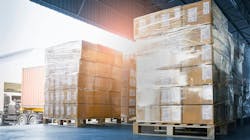Study: Digitizing complicated LTL shipments benefits fleets’ bottom lines
More less-than-truckload fleets are benefiting from digitized shipping records that allow them to provide better visibility through the supply chain, according to a new case study by the National Motor Freight Traffic Association and third-party logistics provider C.H. Robinson. The case study features C.H. Robinson’s eBOL, developed using the standards established by the NMFTA’s Digital LTL Council.
According to the NMFTA’s Digital LTL Council’s website, the council released its first set of LTL eBOL standards in late 2021. The council aims to “facilitate collaboration, automation, standardization, and digitalization across all LTL industry participants.”
In a recent press release about the case study, Greg West, VP of LTL at C.H. Robinson, explained why it’s vital for the LTL industry to digitize.
“While there are fewer carriers in the LTL universe and the top 25 handle over 90% of the market, the complexity of moving LTL freight means that digitization in this part of the logistics industry has been more challenging than truckload,” West said. “With truckload freight, there’s generally one origin and one destination, and a customer has exclusive use of the trailer. With LTL, you can have up to 30 customers’ freight on a trailer, with 30 destinations, and 30 sets of paperwork. That makes it so valuable to have a common eBOL everyone can use.”
See also: The importance of visibility
Case study findings
C.H. Robinson has been using electronic bills of lading for the past year with positive findings, according to the company.
With eBOLs, manual work is eliminated, as tracking numbers for shipments are generated shortly after the shipment is tendered to the carrier; a complete bill of lading is prepared for the shipper before the driver’s arrival. All the driver has to do is scan it.
In addition to eliminating manual work, using eBOLs “provides better end-to-end visibility and reduces entry errors, invoice delays, and administrative costs. They also improve dock efficiency and accuracy of data and billing, which creates an ideal shipping experience,” according to C.H. Robinson’s eBOL guide.
In the past year, 17,240 C.H. Robinson customers benefited from the eBOL. According to the company in a press release, C.H. Robinson has reached 92% accuracy in predicting that an LTL shipment will arrive on time. This accuracy is thanks to a data-science model fed by information on more than 5 million LTL shipments a year across 3 million shipping lanes—more than any other 3PL.
In 2024, C.H. Robinson plans to help other LTL carriers start using eBOLs. According to West, they’ve already helped 10 carriers, and the process is only getting easier. One of these carriers includes Estes Express Lines, whose director of customer success had this to say about C.H. Robinson and eBOLs:
“C.H. Robinson is the largest 3PL in the country,” said Sam Ralat, director of customer success for Estes (No. 11 on the FleetOwner 500: For-Hire list). “Having someone like them adopt a standard creates a snowball effect where people think, ‘Hey, C.H. Robinson got it, which means hundreds or thousands of shipments per day are going through this process. We probably need to look at it too.’”
Outside experts agree that C.H. Robinson is impacting the industry through this eBOL adoption.
“It’s elevated the speed and lowered the cost of maintaining those integrations for carriers who have adopted the standard because they’re all following the formula,” said Brian Thompson, CCO of SMC3. “It goes beyond mapping attributes to business rules, really understanding how the data that flows through is going to impact it. When you’ve got standards and you standardize the attributes, the interpretations and the business rules, it really does facilitate a seamless communication that’s less likely to be misinterpreted.”
About the Author

Jenna Hume
Digital Editor
Digital Editor Jenna Hume joined FleetOwner in November of 2023 and previously worked as a writer in the gaming industry. She has a bachelor of fine arts degree in creative writing from Truman State University and a master of fine arts degree in writing from Lindenwood University. She is currently based in Missouri.
